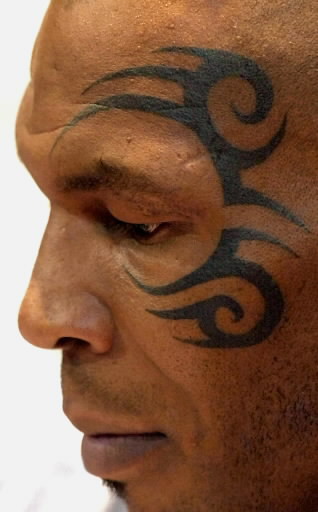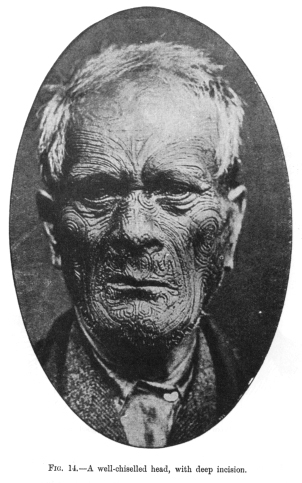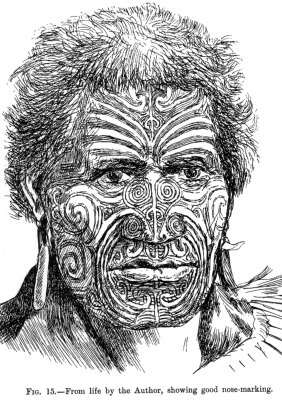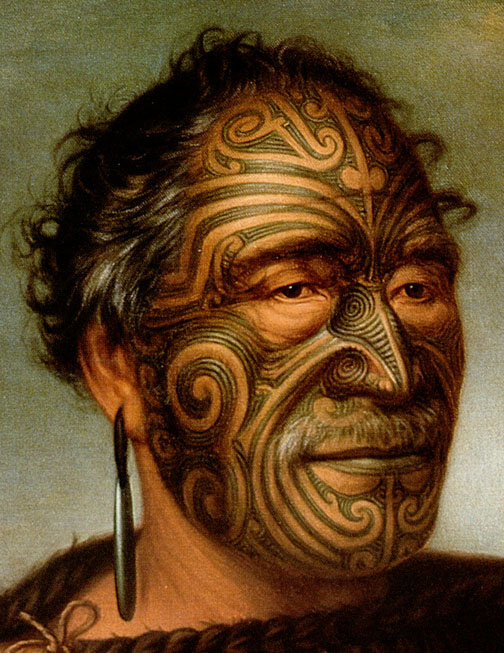First off, I invite you to add your own comments to this one, as I am sure there are aspects to this that I am missing, and I have as many questions as opinions about this one. So, woo-hoo!, Hangover 2 gets to open because a judge rules that even though Victor Witmill does own the copyright to the tattoo design he famously put on Mike Tyson that was then imitated in the film, the financial damage of keeping the film closed would effect too many people to be justified. I’d only followed this with amused interest until I heard an “On the Media” report about the possible ramifications of tattoo copyright — and now I have some questions. (On The Media: This Week ”Can you Copyright the Human Body?)
Is it the norm for a tattoo artist to retain the rights to a design they put on someone else’s skin? Or did it only apply in this case because Tyson is a celebrity and the tattoo artist was seizing an opportunity? What a weird idea that somebody else might own something on your skin. (In a related personal opinion of mine, I think that the models we paint at conventions should be allowed to get copies of all the photographs taken of them…and I’ve been arguing that point with people for a while now)
Secondly, how does a non-Maori tattoo artist get to claim intellectual property rites over an obviously traditional style design? When Tyson first appeared with this thing around his eye I remember how he talked about it’s traditional origins and significance, so what about it makes it something that some tattoo artist can claim as original? I mean, really? (In doing a web search for a common use eligible image of the tattoo I did come across an article from Techdirt about an indignant Maori response to this claim — see the quoted portion below)
However, the larger point I want to make, is what’s up with Tyson’s tattoo in the first place?
From the first I saw it and heard his comments about it, I had to ask: what the….? He talked real big about it being the sign of the warrior and all that, and for a few years afterwards I had all sorts of guys asking me to give them a Tyson Warrior Tattoo. But, what the….?
I’m no expert, just a fascinated artist, but everything I’ve read abut Maori tattoo traditions (“moko”) say that warriors tattooed their whole face, not just some little bit around the eye, and that a big part of the process is enduring the months of painful work required for the full face. I didn’t go back just now to fact-check this little bit but I distinctly remember reading that only priests wore partial tattoos by the eye. Not only did the warriors tattoo the full face, but the designs were incised so deep that the skin became ridged and grooved like a sculpture. In H. G. Robley’s book, Maori Tattooing, first published in 1896 when the tradition was still in general practice, there is not a single example of a man’s face without extensive tattooing.
On the final night at FABAIC, sitting in the outdoor courtyard after the party, I met a gentlemen who was extensively tattooed. He was a soldier, recently back from service, and he was fascinated by the painted people walking through the hotel. We talked about what I did, but then I got him to tell me about his tattoos. The first two he showed me were Cherokee inspired designs on his shoulders, and then others on his arms and legs. Each one marking a place he had been in the service — some, it seemed, for lessons learned and experiences to be cherished (like a samurai inspired mark down the back of his neck from time in Japan) and some for more painful memories. We talked for a while and at one point he asked me if I had any Native American blood in me, and I said no, but that I knew that he was Cherokee, for I had learned from our talk that he wouldn’t wear a mark unless he’d earned it.
From Techdirt:
Maori Angry About Mike Tyson’s Tattoo Artist Claiming To Own Maori …
Professor Ngahuia Te Awekotuku, author of Mau Moko: The World of Maori Tattoo, described Mr Whitmill’s claims of ownership as insufferable arrogance. “It is astounding that a Pakeha tattooist who inscribes an African American’s flesh with what he considers to be a Maori design has the gall to claim that design as his intellectual property,” she said. “The tattooist has never consulted with Maori, has never had experience of Maori and originally and obviously stole the design that he put on Tyson…. The tattooist has an incredible arrogance to assume he has the intellectual right to claim the design form of an indigenous culture that is not his.”
I looked it up, from Wikipedia: Pākehā is a Māori term for New Zealanders who are not of Māori blood lines
source
Search
Followers
Blog Archive
-
▼
2012
(412)
-
▼
July
(22)
- Chest Tattoos For Women
- miley cyrus tattoos
- Audrina Patridge tattoos
- Mike Tyson Tattoos
- Katie Holmes and Suri Cruise photos
- Celebrity that guys are most sick of
- Justin Bieber and Selena Gomez pictures
- Kutcher and Kunis caught kissing (PHOTOS)
- Teen Choice 2012 Red Carpet (10 Photos)
- Amy Winehouse tattoos photos
- Barack Obama and First Lady Michelle Obama kissin...
- Miley Cyrus tattoo on the right rib
- The Amazing Spider-Man LA Premiere pictures
- Katie Holmes fashion and style photos
- Top 10 from a different view point
- Top 7 Pregnant celebrities
- See Lea Michele’s fashion style photos and video
- Niki Taylor tattoos photos
- San Diego Comic-Con in 2012 pictures
- Kate Middleton's Stripper Cousin is Katrina Darlin...
- Fish Huang and You Ya-ting wedding (photos and video)
- Miley Cyrus shows off unlikely new tattoo
-
▼
July
(22)
Popular Posts
-
Chest tattoos for women,breast bone,female chest tattoos,tattoo ideas chest,hot tattoos on women chest,breast bones, breast tattoos can be ...
-
Darren McFadden has never hesitated to show pride in his Arkansas roots. While still in college at Arkansas, McFadden became known for his ...
-
'Pregnant Man' Thomas Beatie Splits From Wife Nancy: Why The Break-Up After 9 Years Thomas Beatie, the world's first 'pregn...
-
Comic-Con officially started Wednesday night, and the cast of Breaking Dawn Part 2 kicked off the four-day-long convention early with a st...
-
Skylar Diggins boyfriend . The big story of the day is that Ben Roethlisberger has officially announced he is getting married. After weeks ...
Copyright (c) 2012 Best Size Wallpapers








